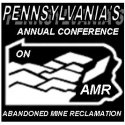
EPCAMR Staff feels this is the most extensive recount of coal mining impact on those who live in and work in the coal region by a newspaper investigation. Thank you, Scranton Times, for working with us!
Investigation Navigation
________________________________________
Part 1 – 1/30/2005
Too Many Mines, Too Little Money
State Program Trying To Make Up for Lost Federal Contributions
Part 2 – 1/31/2005
Danger Lurks in Mines
Part 3 – 2/1/2005
Mining for solutions
Competing plans
Successful reclamation results are all around
Orange water, silver lining
________________________________________
Danger Lurks in Mines
BY JESSICA D. MATTHEWS TRIBUNE STAFF WRITER 1/31/2005

Open Avondale Pit mine, 400 foot deep hole, in Plymouth off of Jersey Road and Route 11. (Edward Pikulski)
The conversation replays in Jacqueline Bertrand’s mind.
She searches for clues as to why her 30-year-old son, James, was driving through a wooded area in Newport Township at 2 in the morning.
Nothing she remembers from their telephone conversation the night before provides answers.
“He said he wasn’t going to be doing anything,” she says. “He said he loved me.”
It was the last time she would hear his voice.
Mr. Bertrand, a volunteer firefighter, drowned last April after the Jeep he was a passenger in plunged off an embankment and into a water-filled strip mine pit.
His death is the sixth at the popular illegal swimming hole and recreational motoring spot near Nanticoke in Luzerne County. In 1998, five friends died after their Jeep also plunged into the 3,000-foot-long pit.
Despite the fatalities, no money has been allocated to reclaim the deadly site under a federal program.
“I just don’t understand why it wouldn’t be fixed,” said Mrs. Bertrand, her voice cracking. “It’s such a danger…You would think they would have done something to prevent another tragedy after the first one.”
Hundreds of other dangerous sites also need cleanup money. A lack of funding and changes allowing money to be spent on a broad range of items — from roads to schools — mean more abandoned mines are not being cleaned up and potential dangers remain.
The program, set to expire in June, is financed by a tax on coal operators.
“It used to be if a there was an injury or death at an abandoned mine site, it was automatically a (higher) priority,” said Gary Greenfield, geologist supervisor with Pennsylvania Department of Environmental Protection’s Bureau of Abandoned Mine Reclamation. “The Office of Surface Mining changed the language. That’s no longer the case. Now a site has to be within 300 feet of a populated area to be considered (higher) priority.”
SETTING PRIORITIES
The federal government classifies abandoned mine problems at five priority levels. The highest-priority problems — those that are supposed to receive federal funding first — pose the greatest danger to public health and safety. Lower priority sites are typically environmental problems, such as water quality.
States ultimately rank projects following federal definitions. The law, however, simply says spending should reflect the priority levels. It does not require states to complete projects based on them, and the federal government does not check spending against priority levels.
“It’s all subjective,” said Bernard McGurl, executive director of the Lackawanna River Corridor Association.
The Newport Township strip mine pit, for example, is listed as a lower priority site containing a hazardous water body, a dangerous embankment and dangerous highwalls. It is estimated to cost at least $5 million to reclaim, as the water would have to be treated and redirected elsewhere.
“It’s in a very remote location,” Mr. Greenfield said. “We have other projects ahead of it. They are a lot closer to residential areas. We’re trying to get it done.”
The site is under reconsideration for funding because a road has opened up in the area, said state Department of Environmental Protection Secretary Kathleen A. McGinty. The open road increases the chances of people getting there and could allow the site to move up the priority list, she said.
Still, another roadblock to cleaning up the site has been getting permission from private property owners to travel through their land to gain access to the site, Mr. Greenfield said. To get to the pit, vehicles must drive through private property.
The land the pit sits on is owned by Ashley-based Earth Conservancy. The nonprofit group was formed by U.S. Rep. Paul E. Kanjorski, D-Nanticoke, in 1992 to reclaim and revitalize 16,300 acres of bankrupt coal company land in Luzerne County.
“People who go there are trespassing,” said Michael Dziak, president and chief executive officer of the Earth Conservancy. “We have put signs up. We’ve blocked the roads with heavy equipment. It’s not easily accessible. Nobody is supposed to go back there.”
The Earth Conservancy has been working with the state and federal government to secure funding to clean up the site.
The price tag, though, would take roughly a fifth of the state’s annual share of cleanup dollars, under current funding.
“The bottom line is we need more money to address these dangerous problems,” Mr. Kanjorski said.
More than 165 people have died in abandoned mines nationwide over the past five years. The majority are drownings at water-filled pits. Many also involve sport utility or all-terrain vehicles.
“Abandoned mines are dangerous,” said Mr. McGurl. “There is no question about that. But, besides the deaths and accidents, they also impede development and are an aesthetic eyesore. They are gaping holes in communities.”
SUPPLY AND DEMAND
Statewide, 2,075 abandoned mine sites need to be reclaimed and have an estimated price tag of $4.9 billion.
In Northeastern Pennsylvania, most of the remaining higher priority sites to be reclaimed are dangerous highwalls, portals, vertical openings and embankments. Reclaiming the sites range from building support walls to filling in openings.
In Lackawanna County, 14 higher-priority problems would cost an estimated $1.1 million to cleanup. The county also has 105 lower-priority sites with an estimated price tag of $30.5 million to reclaim, according to the Office of Surface Mining.
In Luzerne County, 18 higher priority sites would cost an estimated $4.6 million to reclaim. The county still needs roughly $456 million to reclaim all its 211 remaining sites, with about 80 percent of the cost due to seven underground mine fires.
The fires, including one in Wilkes-Barre, are isolated and not able to spread, Mr. Greenfield said. No one lives near them.
“We do monitor them periodically,” he said. “To our knowledge, no one is in any danger.”
“They will eventually burn out. They aren’t anything like what happened in Centralia.”
In Centralia, Columbia County, a fire is believed to have started in a garbage dump of an abandoned stripping pit in 1962. It reached a large anthracite vein under the town and started burning coal. It is still burning.
The federal government spent more than $3.3 million trying to control the fire. It estimated $663 million would be needed to extinguish it. Because of the dangerous gases and hazards associated with the fire, Congress appropriated $42 million in 1984 for the voluntary purchase and relocation of 545 homes and businesses. Only about a dozen homes remain there today.
Few know better than Roaring Brook resident Jack Bravetti about what can happen when abandoned mine problems go unfunded.
While driving along Sadler Avenue in 2003 to visit his daughter in Dunmore, Mr. Bravetti felt a jolt that knocked him unconscious. When he awoke, his minivan was partially swallowed by a mine air shaft that had ripped open and caused a 10-foot hole in the road. The mine subsidence was over the old Underwood Colliery No. 3 Dunmore Coal Bed.
“My minivan was totaled,” the 62-year-old man said. “I was lucky I wasn’t killed. Later, I learned people in that neighborhood had been complaining for a long time about water running down from the abandoned mines. Nobody had done anything to fix the problem.”
Again neighbors were told they had to wait until federal funding became available.
Waiting is not the answer, said Mike Bohan, who volunteered with Mr. Bertrand at Lape Hose Co. Despite Mr. Bertrand’s death at the Newport Township pit and the five others before him, people still hang out there, he said.
“I understand it’s costly to fix these problems but how do you put a price on lives lost?” he asked.
©Scranton Times Tribune 2005













You must be logged in to post a comment.